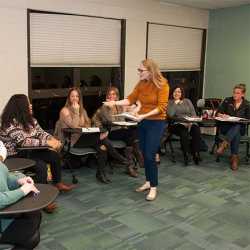 Best Practice Begins With Presence
Best Practice Begins With PresenceBy Daniel Woods
Think of a person in one of your classes. Maybe it's a friend you know well or someone you've barely spoken to. Now imagine the two of you sitting in front of each other without breaking eye contact for two minutes. Does this sound uncomfortable? It is, and my classmates and I can testify to that. Each of us experienced the discomfort of being present and making prolonged eye contact on a regular basis last winter in a graduate clinical mental health counseling class called Foundational Skills in Counseling.
You might be wondering what is so important about making eye contact. Aren't the basic skills used in counseling techniques like active listening and being empathetic? Yes, but even more foundational is the counselor's ability to use their body to effectively connect with the client. With this understanding as motivation, Professor Wood set up a variety of exercises to get us in touch with our bodies before we learned how to say anything to our future clients. We practiced making eye contact and observing how it felt. We practiced grounding ourselves by doing walking exercises as a group. We would march, tiptoe, and side-step around the room in a procession. We practiced attuning to another person by partnering up and mirroring each other's actions and listening to our partners' stories then acting them out using our Best Practice Begins With Presence By Daniel Woodswhole bodies.
The resulting transformation from these exercises and others was highly apparent. We started off as most anyone would, feeling nervous and fidgety, but as we practiced we became calmer and connected to each other like no other class I've ever been in. With this newfound presence to ground us, we dove headfirst into more challenging exercises which would have surely been much more difficult without the previous training. We would get into groups and role play; one person would be the counselor, one the client, and one the witness. This structure was used to practice techniques such as listening and reflecting back feelings and content, making empathic responses, and asking different types of questions. When we role-played as a client, we were asked to be vulnerable and share our feelings in regard to different prompts. The witness would watch and give constructive feedback to the counselor-in-training after each exercise. In this fashion we slowly but steadily improved our ability to connect with ourselves, each other, and ultimately with our clients. We came to understand how important it is to form a bond of trust with a client and how influential both speech and body language is.
All of the theoretical knowledge a counselor acquires will likely go to waste if a client does not feel connected to the counselor. A counselor must know how to actually be present with the client and do it. Getting into the shared space and being open to what's already there is where the work starts. Fortunately for us in the program, this message is not only taught to us but also embodied by all our professors. Whether it was the aforementioned class with Professor Wood, or Psychopathology with Professor Kestemberg, each professor interacts with us in an open and genuinely caring fashion. This is most evident when we have struggles in the classroom, work, or at home, and they do everything they can to help us prevail. While the course content is essential to our education, I believe we can also learn to be better counselors by following the example of our compassionate professors.
Image courtesy of Daniel Woods

